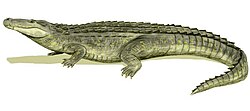| Brachychampsa Temporal range: Late Cretaceous, | |
|---|---|
 | |
| Brachychampsa sp. | |
| Scientific classification | |
| Kingdom: | Animalia |
| Phylum: | Chordata |
| Class: | Reptilia |
| Clade: | Archosauria |
| Order: | Crocodilia |
| Superfamily: | Alligatoroidea |
| Clade: | Globidonta |
| Family: | Alligatoridae |
| Genus: | † Brachychampsa Gilmore, 1911 [2] |
| Species | |
Brachychampsa is an extinct genus of alligatorid, possibly a basal caiman. [4] Specimens have been reported from New Mexico, Colorado, Wyoming, [5] Montana, [2] [6] [7] North and South Dakota, [8] New Jersey, and Saskatchewan, though only those from Montana, Utah, and New Mexico are based on material sufficient to justify the referral. Some specimens have been reported from the Campanian-aged deposits of Central Asia (Chimkent of Kazakhstan and Kirkuduk of Tajikistan), although the species status is indeterminate for these fossils. [9] [10] The genus first appeared during the late Campanian stage of the Late Cretaceous (Judithian North American stage) and became extinct during the late Maastrichtian stage of the Cretaceous (Lancian North American Land Mammal "Age"). Brachychampsa is distinguished by an enlarged fifth maxillary tooth in the upper jaw.
Contents




